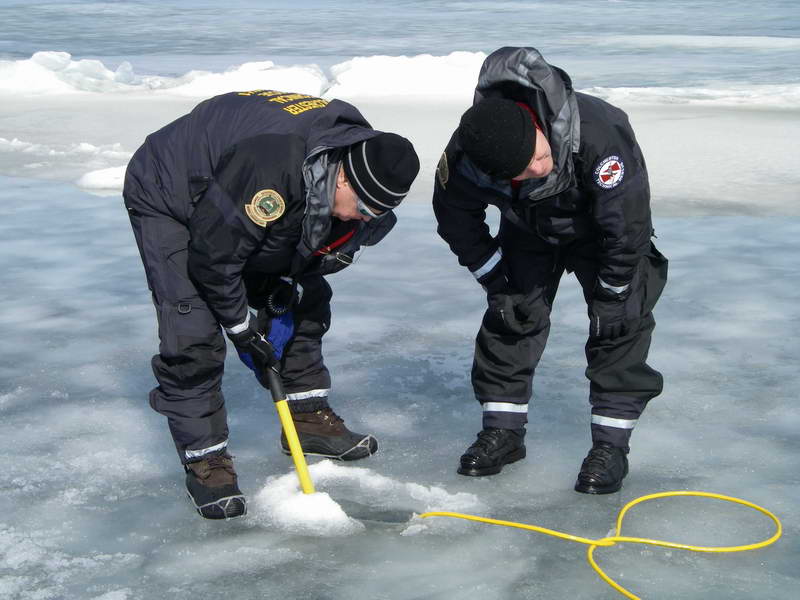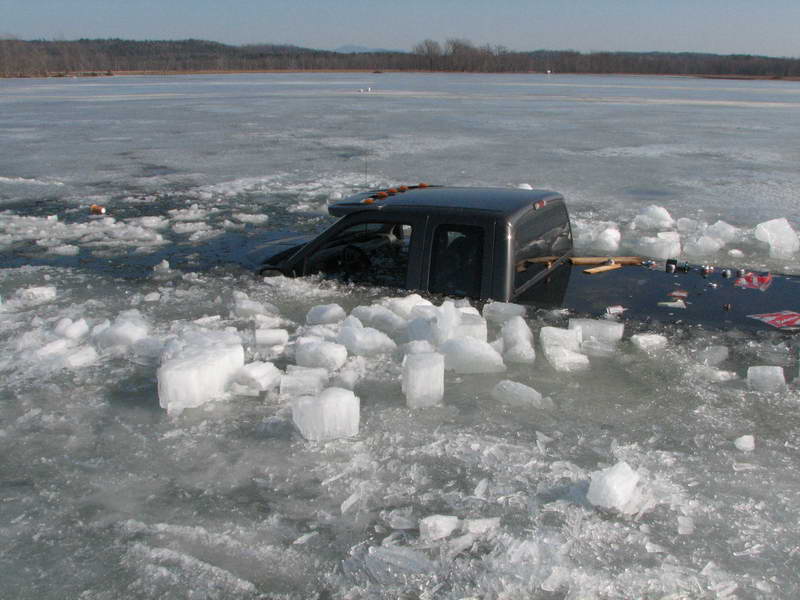 Colchester Rescue (VT) using an underwater camera to search for a missing driver and vehicle.
Colchester Rescue (VT) using an underwater camera to search for a missing driver and vehicle.
Vehicles and Ice
Summary:
Vehicles are involved in over half of lake ice fatalities. While the best advice is to stay off the ice in vehicles, if you chose to drive on ice there are precautions and steps you can take to reduce the risk. Most of the following is oriented to enclosed vehicles but it generally applies to open vehicles as well.
Detail:
Dr Gordon Giesbrecht is an expert on cold water survival who has done considerable work on exiting sinking cars. The full report is an easy and worth while read. A shorter version can be found here (about half way down the page). In the video Rick and Dr Popsicle, Canadian comedian, Rick Mercer, and Dr Giesbrecht demonstrate how to get out of a sinking car. The Minnesota DNR has an excellent website on ice safety. It has a couple sections related to driving on ice and what is likely to happen if a vehicle breaks through. If you ever have or ever will drive on ice, reading and watching all of this is highly recommended.
Click Here for another report of Dr Giesbrecht's recomendations on maximizing your chances of getting out of a sinking car.
The Minnesota DNR has compiled ice accident statistics for the state from 1976 to 2013 involving about 220 fatalities. Sixty percent of them are classified as involving vehicles. About half of those were snow machines which, no doubt, reflects their popularity. December was by far the worst month-three times more vehicle related fatalities than February or March and twice as many as January. The vehicle percentage of all fatalities in December was 70% which leaves the rest of the season with about 55% of fatalities involving vehicles. This strongly suggests that the December might be an especially good time to leave vehicles on shore. This also says that new ice is likely to have weak spots.
Our experience in Vermont is, on average, we loose one or two people a year to ice accidents. The percentage that involve vehicles is similar to Minnesota. About half the vehicle fatalities in Vermont involve pressure ridges. Sometimes people who go through with vehicles are able to get out of the vehicles but are not able to get back on the ice. Ice claws would have saved the day in many cases as would life jackets or float coats.
To state the often under appreciated obvious:
- You are 4 to 40 times heavier than on foot.
- You are in a comfortable place which makes most of us both more confident and more oblivious
- Many of us have a tendency to think 'it won't happen here' or 'this will work out'
- You are removed from many of the visual and other sensory clues you would have if you were on foot.
- It is a pain to stop and check the ice reasonably often.
- It is often difficult to bring the proper assessment tools (especially on a snowmobile or fourwheeler)
- You are likely to be moving quickly compared to walking or skating so you easily cover ground faster than you can assess it and you may not be able to stop before over running any potentially bad areas you do spot.
- When it is dark or the ice is snow covered it makes all these problems worse.
Other considerations if you are going to drive on the ice:
- Before heading out, it is always worth asking yourself if you really need to drive or ride on the ice.
- Have a plan. Prepare for breaking through before you leave shore (See Dr Giesbrecht's home page and MN DNR website). Windows should be down, seatbelt off and speeds low. The bottom line is exit through a side window ASAP.
- Dr Giesbrecht's four word instruction is: SEATBELTS, WINDOWS, CHILDREN, OUT....immediately release your SEATBELTS so you can do everything else, open/break/remove a side WINDOW or two, get the KIDS in the front seat so you can push them out first, Get everybody OUT fast.
- A window breaking tool makes this fast and reliable. Dr Giesbrecht recommends all drivers should carry one of these in a place where they can be found fast (clipped over the visor). Even if you don't plan to drive on ice they can be vital in several other accident scenarios. Getting out through the door only works if the vehicle hangs up on the ice enough to keep the doors unobstructed or after the passenger compartment is full of water and sinking fast. By then your probably of surviving is small.
- Dr Giesbrecht describes three phases of sinking:
- Floating until the water gets to the bottom of the windows
- Sinking as the windows start to go under the water. Water pressure and electrical shorting may prevent window from being opened (see below).
- Submerged is when all the air in the vehicle is gone. If the doors are not obstructed by mud from the car landing on its roof, you might be able to open the doors.
- If you were too slow to get out the windows, are not dead yet and are able to open a door, remember to look up so see the hole and the ice blocks you will have to thrash through if you make it to the surface. In spite of some stories about swimming back to the hole the chances of pulling that off are slim. Exiting after the floating phase should not be part of your plan.
- Other vehicles (snowmobiles to tractors) have their own problems. Sleds have the potential to plane across water but that is lost if the drive belt gets wet. Also, skimming is easy to flub. The odds of surviving are best if you sink at the edge of thicker ice. The same is true for ATVs. UTVs are heavier and often have a cab. They probably have a rapid sink time. Tractors sink fast and most have cabs.
- They guys in the 2012 Waterbury Reservoir accident were able to get directly onto the ice sheet from the divers side window. The second guy was not fully free of the vehicle until just before it went under. He got pretty wet from the water rushing in the window as he was pulled out.
- In Waterbury the vehicle hung on the ice a little on one side leaving one window a little higher...a good reason to pick it as your exit window.
- Don’t count on your electric windows or door locks working if they are underwater. Dr Giesbrecht found that even crank windows may not work once the window is submerged because of the water pressure presses the window against the door frame. Carry a window breaking tool and seat belt cutter. In Vermont they are not easy to find. (Click here for an online seller of window breaking tools.) Gerald Dworkin, who works with Lifesaving Resources, points out in their Ice Rescue Technician Guidebook that the center punch (spring loaded) Rescue-Me type window breakers can become dull and less effective after repeated use. His recommendation is to only use them when needed and only on glass. For perspective on this, I have used a Rescue-me widow breaker about 200 times on glass, a steel hammer face and quarzite. So far it still breaks tempered windows reliably. Even so, if you want to try yours out, do it on something soft, like wood. Trying a Rescue-Me on a junk car window will make a lasting impression about how effective they are.
- If your car has laminated side windows a window breaker will not work and laminated are very hard or impossible to break enough to get through them by kicking form the inside. They are starting to be found on a few higher end cars and some Chrysler products (often with sound deadening packages). The only good alternative is have the widows down. You can tell if windows are laminated two ways. They are marked as such on one of the lower corners. Also, if you look closely at the edge of the glass when the window is down, there is a line along the center of the edge where the very tough plastic film resides.
- Pressure ridges account for many vehicle breakthroughs. They are always dicey to cross but if you choose to cross one, consider having all your passengers watch from the ice. Any ridge that can be crossed in a vehicle should be easy to cross on foot.
- The advice I got from a marine salvage expert: Know the lake: particularly currents, bottom profiles and locally known problem areas. This is especially true early or late in the season and if there is snow on the ice.
-
Other vehicles on the ice can be a poor basis for deciding it is OK for yours.
-
Many vehicles over the same ice can work it enough to make it weaker. This is a problem around access ramps, especially when the ice is thin or thawed.
- Speed may be fun but it is not your friend: It adds a high speed crash as you break through and it makes it much less likely you will be able to stop if you spot trouble.
- In the spring the ice is thick but weak. It feels great in the morning when the overnight ice has hardened up the upper layer. Later in the day the surface is soft and the ice sheet has absorbed another day of the strong March sun.
 Mid March, warm, sunny day, well thawed small-medium grain ice. Broke through at 4PM. 8" held the truck, 7" did not.
Mid March, warm, sunny day, well thawed small-medium grain ice. Broke through at 4PM. 8" held the truck, 7" did not.
- Eric Anderson (CT DN sailor) describes the effect of waves created by vehicles moving over the ice. At certain speeds the waves can build a lot of energy. Eric described one situation where a fast moving vehicle traveling along a pressure ridge about 30 feet away caused 100 feet of the ridge to rupture. He also points out that fast vehicles that are headed for an exit ramp can create a wave that will rupture the ice at the edge of the ramp. No fun for the people who follow.
- Popular Mechanics wrote an article on ice safety with a lot of detail on vehicles in December 1983. Google Books has brought it back to life.
- On November 24th, 2010, MYTHBUSTERS did a show that included getting out of an inverted underwater car in warm water. Even in that controlled environment, Adam needed to use the back up air tank to get out. One of Adam's conclusions is to start carrying a window breaking tool in his car.
- For heavier vehicles read Exit Strategies and Safety Considerations for Heavy Machinery Occupants Following Ice Failure and Submersion. They found a five ton truck sank in an estimated three seconds!...something to think about if you are considering plowing snow on an ice sheet. (See this in real life) A more typical pickup with a plow and a crew cab had a seven second floating phase. A typical car (without rust holes in the floor) floats for more like 60-120 seconds.
- If you are driving a beater, plan to exit fast. One of Gordon's test cars had rust holes in the floor and was in the sinking phase in 26 seconds. I expect a small cab pickup is likely to have a short floating phase as well because of its small cab volume relative to its weight.
The following link is to an excellent article on vehicle recovery from the Twin Cities Pioneer Press.
